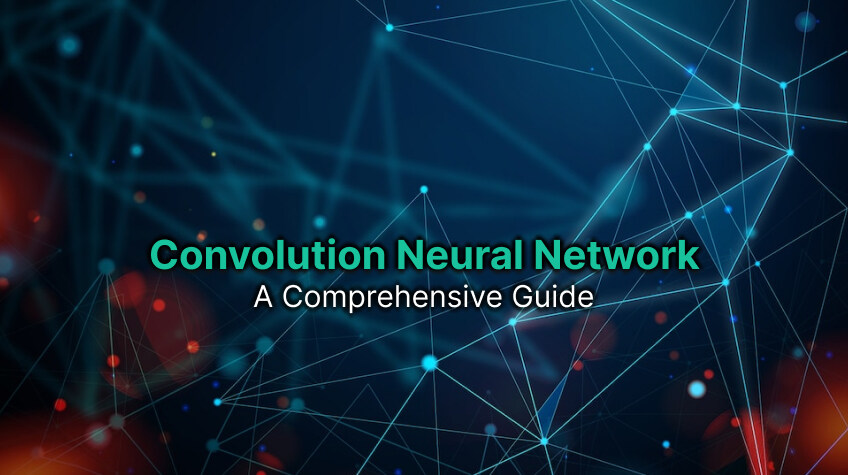
In the ever-evolving landscape of artificial intelligence, Convolutional Neural Networks (CNNs) have arisen as a powerful tool that has revolutionized the field of computer vision. Designed to mimic the human visual system, CNNs excel at recognizing patterns and features in images, making them indispensable for tasks like image classification, object detection, and semantic segmentation. These sophisticated networks have achieved unprecedented success in various real-world applications by leveraging the power of convolution, pooling, and non-linear activations.
In this comprehensive guide, we will delve into the inner workings of CNNs, explore their architectures, understand their strengths, and witness how they continue to reshape the future of AI-powered visual understanding.
What is Convolutional Neural Network?
A Convolutional Neural Network (CNN) is a specialized deep learning architecture used to analyze videos and images. Inspired by the human visual system, CNNs comprise multiple interconnected layers, each performing specific tasks. The core function in a CNN is convolution, where filters extract relevant features from input data.
These features are then combined through pooling and regressed with fully connected layers. CNNs have demonstrated remarkable performance in various image recognition, object detection, and image segmentation tasks by learning hierarchical representations automatically and capturing complex patterns, enabling breakthroughs in fields like image recognition, object detection, and image segmentation.
How does Convolution Neural Network work?
Convolutional Neural Networks (CNNs) work by leveraging the concept of convolution to process visual data effectively. The network consists of layers with learnable filters, which slide over the input data, extracting relevant features through element-wise multiplication and summation. These extracted features are then subjected to non-linear activation functions, enhancing the network’s ability to learn complex patterns and relationships.
Pooling layers lessen the spatial dimensions, retaining critical information while dumping unneeded components. The final layers perform classification or regression based on the learned features. The hierarchical nature of CNNs enables them to automatically learn and identify features at different levels of abstraction, making them highly effective for various computer vision tasks.
Convolutional Neural Network Architectures
CNN architectures are specialized deep-learning models for computer vision tasks. Here we have mentioned some important ones in detail.
1. LeNet-5
LeNet-5 is a trailblazing Convolutional Neural Network (CNN) conceived by Yann LeCun. in 1998. It marks a pioneering milestone in the application of CNNs to computer vision. Initially developed for handwritten digit recognition, LeNet-5 successfully demonstrated the power of convolutional layers in extracting features from images.
Comprising seven layers, including convolutional, pooling, and fully connected layers, it laid the groundwork for subsequent advancements in deep learning. Its robustness and accuracy in recognizing handwritten digits played a pivotal role in shaping the landscape of modern CNN architectures. They paved the way for their widespread adoption in various image-related tasks.
2. AlexNet
AlexNet, a seminal Convolutional Neural Network (CNN) designed by Alex Krizhevsky, achieved a groundbreaking victory in the 2012 ImageNet Large Scale Visual Recognition Challenge (ILSVRC). This watershed moment has heralded the deep learning era, revolutionizing computer vision tasks. With its innovative architecture of stacked convolutional layers, ReLU activation, and GPU-accelerated training, AlexNet significantly outperformed traditional machine learning methods.
Its success popularized the adoption of deep learning techniques across various domains, spurring intense research and inspiring the development of more complex CNN architectures. The impact of AlexNet’s victory continues to shape the landscape of artificial intelligence and reaffirms the significance of CNNs in modern AI applications.
3. VGG-16 and VGG-19
VGG-16 and VGG-19 are renowned Convolutional Neural Network (CNN) architectures developed by the Visual Geometry Group at the University of Oxford. They are distinguished by their uniform structure, emphasizing depth, with mainly 3×3 convolutional layers and 2×2 pooling layers. These networks demonstrated the significance of increasing model depth for improved performance in image recognition tasks.
Despite their simplicity, VGG-16 and VGG-19 achieved remarkable results in the 2014 ImageNet competition, showcasing the potential of deep CNNs. Their influence on subsequent architecture design and the emphasis on deeper networks have become essential pillars in modern deep learning research.
4. GoogLeNet
GoogLeNet, also known as Inception v1, is a groundbreaking Convolutional Neural Network (CNN) architecture developed by researchers at Google. It introduced the innovative “inception module,” incorporating multiple filter sizes (1×1, 3×3, and 5×5) within a single layer. This efficient design reduced the parameters and computational complexity while enhancing the network’s ability to capture diverse features at different scales.
GoogLeNet achieved remarkable performance in the 2014 ImageNet competition by winning in accuracy and computational efficiency. Its inception module inspired subsequent versions and motivated research in optimizing CNNs, making it a pivotal contribution to deep learning.
5. ResNet
ResNet, or Residual Networks, represents a monumental advancement in deep learning. Proposed by Kaiming He., ResNet introduced the concept of skip connections or residual blocks, which allowed gradients to flow straight through the network, alleviating the vanishing gradient issue.
This breakthrough innovation enabled the training of remarkably deep CNNs, surpassing previous limitations on depth. By reusing learned features through shortcut connections, ResNet facilitated smoother optimization and significantly improved accuracy. Its introduction in 2015 led to an explosion of interest in training intense neural networks, becoming a cornerstone in modern architecture design and propelling the field of computer vision forward.
6. DenseNet
DenseNet, a pioneering Convolutional Neural Network (CNN) architecture, introduced the concept of dense connectivity. Developed by Gao Huang, DenseNet connects each layer to all preceding layers in a feed-forward manner, creating a dense interconnection among network blocks. This design fosters direct feature reuse and enhances information flow throughout the network.
By facilitating comprehensive information exchange, DenseNet promotes more profound and efficient feature learning, improving model accuracy. Moreover, this parameter-efficient architecture addresses the vanishing gradient problem, enabling ease of training even in deeper networks. DenseNet’s remarkable success in various computer vision tasks has solidified its significance as a highly influential CNN architecture.
7. MobileNet and MobileNetV2
MobileNet and MobileNetV2 are cutting-edge Convolutional Neural Network (CNN) architectures explicitly designed for mobile and edge devices. Developed by Andrew G. Howard. and Mark Sandler, respectively, these models prioritize lightweight and efficient computations to accommodate the limited resources of mobile platforms.
MobileNet achieves this by using depthwise separable convolutions, a method that reduces computational complexity without sacrificing performance. MobileNetV2 further enhances efficiency with inverted residual blocks and linear bottlenecks. By focusing on compact yet accurate models, MobileNet and MobileNetV2 have become go-to choices for on-device AI applications, enabling a wide range of real-time and power-efficient computer vision tasks on mobile and edge devices.
8. EfficientNet
EfficientNet is a groundbreaking Convolutional Neural Network (CNN) architecture that introduced compound scaling to balance model size and performance. Proposed by Mingxing Tan and Quoc V. Le, EfficientNet achieves state-of-the-art results by systematically scaling up the network’s depth, width, and resolution using a novel compound coefficient.
This innovative approach optimizes the model’s architecture for various resource constraints, effectively maximizing performance while reducing the number of parameters. By doing so, EfficientNet has revolutionized the field of deep learning by providing highly efficient and accurate models, making it a go-to choice for diverse computer vision tasks, even in resource-constrained environments.
Convolutional Neural Network Layers
Several layers in a typical Convolutional Neural Network (CNN) serve different feature extraction, learning, and decision-making purpose. The most common layers in a CNN include the following
1. Input Layer
The Input Layer in a Convolutional Neural Network (CNN) serves as the initial entry point for data. It receives raw input, typically in the form of images or pre-processed feature maps. The layer’s dimensions are determined by the size of the input data, defining the spatial dimensions and the number of channels.
The input layer does not involve any learnable parameters; its purpose is to pass the data forward through the subsequent layers of the CNN. Correctly setting the input layer dimensions is crucial for the network to process and extract relevant features effectively, making it a fundamental component in the architecture’s overall design.
2. Convolutional Layer
The Convolutional Layer, a vital component in Convolutional Neural Networks (CNNs), executes the core operation of convolution. It employs learnable filters or kernels that slide over the input data, extracting essential features and patterns. Each filter applies element-wise multiplication and summation, producing feature maps highlighting specific data patterns.
These feature maps represent higher-level representations, enabling the network to capture intricate spatial dependencies in images. The ability of convolutional layers to learn and recognize local features makes CNNs proficient in various computer vision tasks, such as image recognition and object detection, revolutionizing the field of deep learning in visual data analysis.
3. Activation Layer
The Activation Layer plays a critical role in Convolutional Neural Networks (CNNs) by introducing nonlinearity. It applies activation functions like ReLU (Rectified Linear Unit) element-wise to the output of the convolutional layer. ReLU sets negative values to zero while retaining positive values, enabling the network to learn complex and non-linear relationships in the data.
This nonlinearity is essential for CNNs to model intricate features and relationships, allowing them to excel in recognizing images and detecting objects. Activation functions bring the much-needed capacity for capturing high-level abstractions, making CNNs powerful tools for visual pattern recognition and analysis.
4. Pooling Layer
The Pooling Layer is a crucial element in Convolutional Neural Networks (CNNs) that aids spatial down-sampling. It decreases the spatial dimension of feature maps obtained from the preceding convolutional layers. The layer retains essential information by applying operations like max-pooling or average pooling while discarding less significant details, thereby reducing the computational burden.
Pooling serves two critical purposes: it helps prevent overfitting by reducing the network’s sensitivity to minor spatial shifts. It enhances computational efficiency, allowing CNNs to process more extensive and complex visual data quickly. This spatial reduction enables CNNs to capture meaningful patterns at different scales, improving their overall performance in various image-based tasks.
5. Fully Connected Layer
The Fully Connected Layer, commonly known as the Dense Layer, plays a crucial role in Convolutional Neural Networks (CNNs). It establishes connections between every neuron from the previous layer to each neuron in the current layer, creating an entirely interconnected structure. By flattening the feature maps into a one-dimensional format, this layer prepares the data for classification or regression tasks.
It is the final stage of the feature extraction process, transforming the extracted features into meaningful predictions. The Dense Layer’s ability to capture complex relationships and patterns enables CNNs to make accurate decisions and classifications based on the learned representations from earlier layers.
6. Output Layer
The Output Layer is the final component of a Convolutional Neural Network (CNN), responsible for producing the network’s ultimate predictions. Depending on the task, the Output Layer generates either class probabilities for classification tasks or continuous values for regression tasks. For classification, it employs activation functions like Softmax to convert the network’s raw outputs into probability distributions across different classes.
In regression tasks, the Output Layer directly provides continuous values without activation. This layer represents the network’s decision-making stage, as it outputs the model’s confident predictions based on the learned features from the previous layers, making it a critical part of CNN architectures.
Advantages of Convolution Neural Network
- Feature Learning: CNNs learn hierarchical and abstract features from data without human intervention.
- Spatial Invariance: Convolutional operations enable CNNs to recognize patterns irrespective of their position in the input, enhancing robustness.
- Parameter Sharing: By sharing weights across the network, CNNs are computationally efficient and require fewer parameters than fully connected networks.
- Reduced Overfitting: Pooling and dropout layers prevent overfitting, enhancing generalization to unseen data.
- Versatility: CNNs excel in various computer vision tasks, including image classification, object detection, segmentation, and style transfer.
- Transfer Learning: Pre-trained CNN models can be fine-tuned for new tasks with limited data, accelerating model development.
- Real-Time Processing: Lightweight CNN architectures enable real-time inference on mobile and edge devices.
- State-of-the-Art Performance: CNNs consistently achieve top performance in benchmark datasets and competitions, outperforming traditional methods.
Disadvantages of Convolution Neural Network
- Computational Cost: Training CNNs can be computationally expensive, especially for deep networks and large datasets, requiring powerful hardware or cloud resources.
- Large Memory Footprint: CNNs with many layers demand significant memory, limiting their deployment on memory-constrained devices.
- Overfitting: Deep CNNs may suffer from overfitting, especially when trained on small datasets, necessitating regularization techniques.
- Parameter Sensitivity: CNN performance can be sensitive to hyperparameters, necessitating careful tuning for optimal results.
- Interpretable Black Boxes: CNNs lack transparency in understanding how they arrive at their decisions, making them difficult to interpret and trust in critical applications.
- Data Augmentation: Augmenting training data is often essential for generalization, which can be challenging and time-consuming for some domains.
- Training Complexity: Fine-tuning CNNs for specific tasks requires significant expertise, limiting their accessibility to non-experts.
- Limited Rotation and Scale Invariance: While CNNs show translational invariance, they may struggle with recognizing objects under rotation or scale transformations.
Applications of Convolution Neural Network
⁍ Image Classification: CNNs excel in categorizing images into various classes, powering applications like facial recognition, object identification, and scene recognition.
⁍ Object Detection: CNNs are widely used in detecting and localizing multiple objects within images or videos, which is essential for autonomous vehicles and surveillance systems.
⁍ Semantic Segmentation: CNNs accurately segment images into different object regions, enabling a precise understanding of scene components.
⁍ Image Style Transfer: CNNs can transform the style of an image to mimic artistic styles, producing impressive visual effects.
⁍ Medical Imaging: CNNs aid in diagnosing and analyzing medical images, assisting doctors in detecting diseases and anomalies.
⁍ Natural Language Processing: CNNs are applied in text classification, sentiment analysis, and language translation tasks.
⁍ Autonomous Systems: CNNs are pivotal in developing self-driving cars and drones, enabling object detection and navigation.
⁍ Video Analysis: In surveillance and sports analytics, CNNs process video data for action recognition, tracking, and event detection.
⁍ Speech Recognition: CNNs play a role in speech-processing applications like automatic speech recognition and speaker identification.
⁍ Gaming: CNNs enhance gaming experiences by enabling real-time character and object recognition, leading to interactive gameplay.
In conclusion, this comprehensive guide to Convolutional Neural Networks (CNNs) has shed light on the transformative power of this remarkable deep-learning architecture in computer vision. From the early pioneers like LeNet-5 and AlexNet to modern giants like ResNet, DenseNet, and EfficientNet, we have explored the evolution of CNN architectures and their groundbreaking contributions. CNNs have demonstrated unrivaled success in image recognition, object detection, segmentation, and more, owing to their ability to learn intricate patterns and hierarchies automatically.
Their widespread applications across industries, including healthcare, autonomous systems, and entertainment, reinforce their indispensability in shaping the future of AI-driven visual understanding. As CNN research continues to evolve, we anticipate even more remarkable advancements that will push the boundaries of computer vision and AI.






